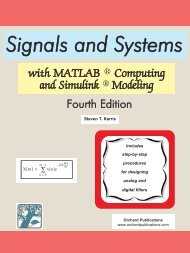COMPUTING
Second Edition - Orchard Publications
Second Edition - Orchard Publications
- No tags were found...
You also want an ePaper? Increase the reach of your titles
YUMPU automatically turns print PDFs into web optimized ePapers that Google loves.
Chapter 5 Operational Amplifierswe can plot the output versus inputs of the R−2R network for the voltage levels 0 V and 4 V asshown in Figure 5.86.V out ( V)4.03.53.02.52.01.51.00.501 2 3 4 5 6 7 8V in ( V)Figure 5.86. Output vs. inputs for an R−2R network with levels 0 to 4 voltsA typical DAC must include an op amp to match the resistive network to a low−resistance loadand to provide gain also. Placing an impedance−matching device (the op amp in this case) at theoutput of the resistive network is called buffering the output of the network. Figure 5.87 shows anR−2R type DAC with buffered output and gain.R 1R f2R2RR R R2R 2R 2RV analogV A V B V C V DFigure 5.87. Op amp placed between the resistive network and output for buffering and gain5.24 Analog−to−Digital ConvertersOften an analog voltage must be converted to a digital equivalent, such as in a digital voltmeter.In such cases, the principle of the previously discussed digital−to−analog or D/A converter orsimply DAC can be reversed to perform analog−to−digital A/D conversion. There are differenttypes of analog−to−digital converters, usually referred to as ADC, such as the flash converter, thesuccessive approximation converter, the dual−slope converter, and the Delta−Sigma algorithmic5−56Electronic Devices and Amplifier Circuits with MATLAB Computing, Second EditionCopyright © Orchard Publications







